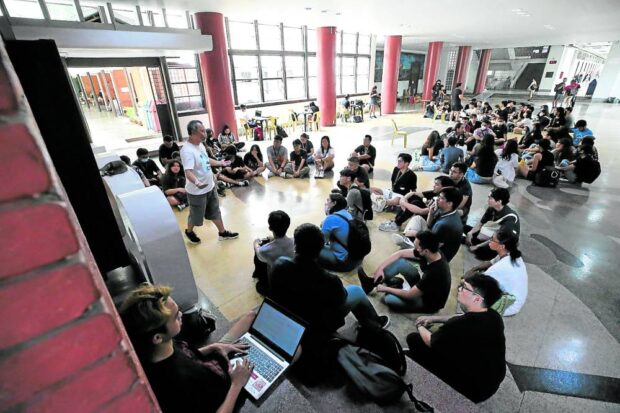‘Poorest of poor’ shrinking among college aid grantees

College students at the lobby of Palma Hall at the University of the Philippines in Diliman, Quezon City. (INQUIRER FILE PHOTO)
MANILA, Philippines — Fewer and fewer students classified among “the poorest of the poor” are receiving tertiary-level education assistance from the government, with the number of such beneficiaries sharply dropping by more than 130,000 from 2018 to 2022, a periodic education monitoring report has shown.
The Second Congressional Commission on Education (Edcom II) published its report titled “Miseducation: The Failed System of Philippine Education,” which it submitted to both chambers of Congress on Monday and Tuesday.
The 398-page report contains the body’s findings and recommendations to improve the country’s education system.
Among the observations highlighted by the commission was the “inequitable distribution and utilization” of resources that “resulted in unequal access to higher education.”
The report was referring to tertiary education subsidies (TES) under Republic Act No. 10931, or the Universal Access to Quality Tertiary Education Act, which had widened access to the free higher education program among Filipino students in tertiary-level education, including those pursuing undergraduate college degrees.
Article continues after this advertisementREAD: SUCs eyed as specialty ‘feeder schools’
READ: Groups want more time before cancellation of SHS program in SUCs, LUCs
Subsidy for tuition, fees
Under the law, TES are supposed to cover the tuition and other school fees of students who are academically capable but financially disadvantaged, should they decide to attend a private university or college, the Edcom II report pointed out.
Article continues after this advertisementThe subsidies are also intended to cover these students’ expenses on books, school supplies, transportation, and other needs to complete their degree programs, it added.
However, the commission found that the number of TES grantees categorized under the extreme poverty sector, or those listed under the Pantawid Pamilyang Pilipino Program (4Ps) and other antipoverty programs, has been declining over the years.
Not only that, “their proportion within the total distribution” has also decreased, according to the report.
Based on official data, a total of 204,234 students under the category received the TES grant in 2018, accounting for 74.24 percent of the total, but this “sharply declined” to 69,887, or 30.74 percent, by 2022.
Edcom II’s data was sourced from the September 2023 figures of the Unified Financial Assistance System for Tertiary Education.
Displaced by PNSL
At the same time, the number of grantees from private higher education institutions in municipalities and cities without state and local universities and colleges (SUCs/LUCs), or those referred to as “placed with no SUC/LUC” (PNSL), saw an increase from 70,684 students to 157,484 in the same period, according to the report.
“This shift is notable as students in the PNSL category may not necessarily be impoverished, contradicting the progressive goal of the [Universal Access to Quality Tertiary Education] Act,” the commission said in its report.
“The substantial rise in PNSL grantees, both in number and proportion, suggests that the TES [are] no longer targeted toward those who need it most,” it said.
The commission suggested a “reevaluation” of the definition of PNSL, which it said could “better align” with the objectives of the law and ensure equity among student grantees.